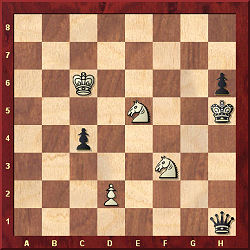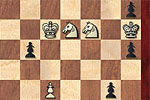The Behting Study revisited
Kiyoshi Takahashi's article on deceiving computers forced us to revisit a study we have been using for many years now. The story begins in 1983, when, as a rooky journalist, Frederic Friedel co-founded the first German computer chess magazine, Computerschach & Spiele. In the very first issue of the magazine he presented a study about which he wrote the following: "Why will computers beat world champion Anatoly Karpov" [ah, yes, Tolya ruled at the time] "before they will be able to solve the following study." And then he presented the famous "Behting Study".
K. K. Behting, Baltische Schachblätter 1908

White to play and draw
This, we wrote, is not a very complex position. Just two knights and a few pawns. But it goes beyond the horizon of most computers – and most human beings. Try to work it out. Normally we tend to ask our readers to solve puzzles and problems without seeking assistance from the electronic smarty-pants. In this case we explicitly ask you to analyse the position with the finest chess program and most powerful computers at your disposal. The best way to go about it is to play the white side and let the computer attack with the black pieces. Unless you find the one correct solution it will frustrate your every attempt to hold the position for white.
On the other hand you can let the chess program work on the diagram position, for many hours – or days if necessary. It is probably too much to expect it to find the correct first move with a 0.00 evaluation (indicating a draw). But it would be interesting to know if a computer can find the correct solution, even though it thinks that the position is still hopelessly lost for White.
So what is this mysterious, this legendary first move? Well, simply one of the deepest we have ever encountered in a chess study. It is also enchanting to note that revealing the solution would involve showing people the first three white moves and then briefly explain a logical point. After that you would immediately agree that the position is a dead draw, that indeed the solution is perfectly correct.
The solution
Well, here's the solution, which we presented six years ago in our Christmas Puzzle section: 1.Kc6!! Truly staggering that only this move secures the draw. The reason will become clear shortly. 1...g1Q. This is the only reasonable attempt for Black to win. In the attached analysis we show why 1...h3 or 1...Kg5 only draw. 2.Nxh4! Qh1+. Black has only this one check, which is the reason that 1.Kc6!! was required in the starting position. 3.Nhf3 ½-½.

Take a look at the position. The black king has been completely immobilised by the two knights, which protect each other and the pawn on d2. White will simply leave these three pieces in place and move around with his king. Black can only give checks with the queen, and White only needs to avoid the king getting stalemated in a corner. The position is an iron draw.
Two questions remain: are the current generation of super-duper chess programs still unable to cope with this simple three-move study? (We should mention that there was one, Patzer by Roland Pfister, that solved it years ago – but as Pfister himself admitted, the program contained "special Behting Study code"). No reader sent us information on a chess engine playing 1.Kc6!! and perhaps evening giving a draw evaluation. The latter would not be necessary – often computers will find a fortress and hold a cast-iron draw, but still display a very negative value for the position. But at least it should find that 1.Kc6 is better than all other moves, which lose within the horizon of the search tree. Unless...
There is a possibility that the study is not sound, and that another move will also secure the draw. We asked our readers to investigate this possibility, but few did, since we had not actually given the intended solution. One who knew it was Dr John Nunn, who in spite of being occupied with the construction of a super-fast new computer (6 x 3.8 GHz cores, overclocked, 16 GB memory), spent a little time with the study. He wrote:
The Behting study has often been used in discussions about positions computers find difficult to solve, but I wonder if the study is actually sound, since White has a possible alternative to the intended 1 Kc6. After 1 Ng7+ Kg5 2 Nf3+ Kg4 3 Ke4 h3 4 Nf5 g1Q 5 Nxg1 h2 6 Nxh6+ Kh5 (6...Kg3 7 Nf5+ Kg2 8 Nf3 h1Q 9 N5d4 is very similar) 7 Nf3 h1Q 8 Nf5 Kg4 9 Ne3+ Kg3 10 Nf5+ Kf2 11 N5d4 we reach an interesting position with Q+P vs 2N+P. Since in general positions with Q v 2N are drawn, if Black is to win he has to make progress without allowing an exchange of pawns. It isn't obvious how he can do this, although there are various attempts which come close to succeeding. It may well be that there is such a method, but I have not been able to determine if Black can win. Perhaps readers with more analytical power or someone with a seven-man database can resolve this.
So here is the task: in the following position
is it possible to show a convincing win for Black? Maybe readers can experiment with very deep searches or even use the Monte Carlo analysis function provided in the Fritz/Rybka interface to evaluate the position. We add the following analysis, collected so far, in replayable form:
If you write to us please include "Behting study" in the subject line, otherwise your message is likely to be missed. Also just give the new lines of your analysis, which should not be buried in the notation of the PGN given above.



























